Rules for Traditional Thai Boxing
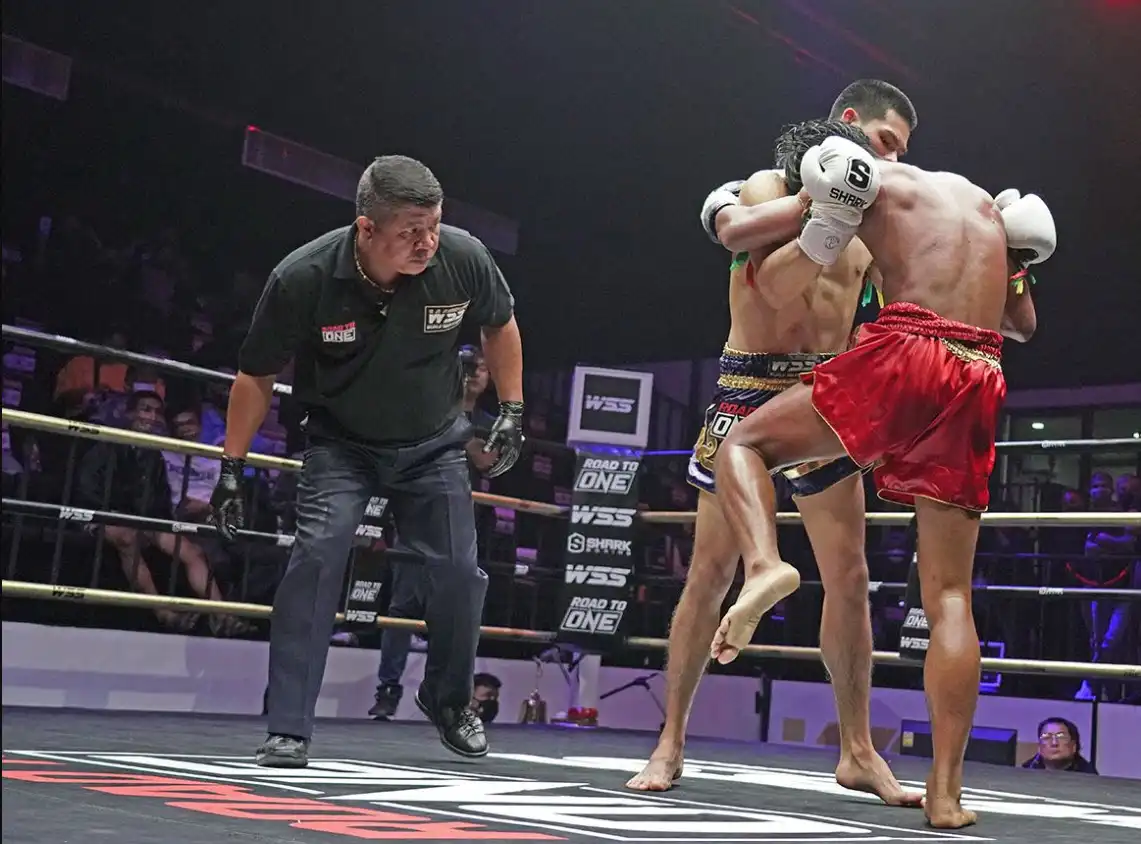
Rating: 5/5 (1 votes)
Phranakhon Si Ayutthaya attractions
Attractions in Thailand
Rules for Traditional Thai Boxing Competition Rules and regulations for Muay Thai competitions. The modern Muay Thai rules are clearly defined and cover every aspect of Muay Thai competition. Currently, boxers must wear 4-ounce gloves and dress like a boxer. Wear shorts and tights. You can wear foot support or not. The talisman can be tied on the upper arm. As for other amulets Can be worn only during the Wai Khru dance. and must be removed at the start of the competition. In the competition, there is 1 referee on the stage and 2 referees at the ringside. The number of rounds in the competition has 1 referee on the stage, 2 judges at the ringside. The number of rounds in the competition is 5 rounds, each round lasts 3 minutes.
There is a 2 minute break between rounds. The competition is divided into divisions based on the boxer's weight similar to international boxing rules. The organs used in fighting include fists, feet, knees, elbows, punches, kicks, and kicks, etc., all parts of the body. Without limiting the area of the punch Some very dangerous Muay Thai moves are strictly prohibited, such as the Lak Phet pose, which is a position where the leg is grabbed and broken by sitting on it, etc.

1. Stage, arena for general Muay Thai competitions The size of the stage has been determined. and set it as follows:
1.1 The ring is a place that is assembled for use in boxing competitions. It must be built strong, safe, level, and free from any obstructions. and the stage floor must stand at least 9o centimeters outside the rope barrier.
1.2 The stage floor must be built to be safe. It must be at least 1.20 meters and not more than 1.50 meters above the standing area, with poles set up at the corners on all 4 sides, with diameters of 10 - 12.5 centimeters and elevated from the ground. The location is not more than 2.85 meters. The stage floor must be covered with soft materials such as rubber, soft cloth, sponge or other materials. that have similar characteristics It has a thickness of between 2.50 - 3.75 centimeters, covered with canvas to be taut, smooth and completely covering the entire stage floor.
1.3 When installing the arena, the red corner must be on the left hand side of the chairman of the referee's table. The blue corner is opposite the red corner. The other two corners are middle angles.
1.4 The stage divider has 4 ropes, covered with soft and smooth material. It has a diameter of 3 - 5 centimeters and is taut with the four pillars of the stage. Each rope is 45 centimeters high from the stage floor to the top of the rope. The second rope is 45 centimeters high.is equal to 75 centimeters, the third rope is equal to 1.05 meters, and the top rope is equal to 1.35 meters, respectively. The four ropes on each side must be tied together with two pieces of sticky cloth, 3 - 4 centimeters wide, equally spaced. The tied cloth must be firmly fixed. All four corners must be covered with padding or other material. To prevent danger to the boxer, there must be a ladder at the red corner. and blue corner To allow boxers, mentors, referees, and field doctors to perform their duties.
1.5 Attach plastic boxes or boxes made of other materials to the two middle corners. (Outside the ring) 1 box per corner for the referee to discard cotton balls. or things that are no longer used.
1.6 The ring is a part of the stage that is square. Measured from inside the rope. The small size has a length of 6 meters on each side. The large size has a length of 6.50 meters on each side.
1.7 Stage, ring and stage divider rope that are not included in the regulations and rules of Muay Thai in Parts 1, 2, and 3 according to the Boxing Act of 1999 to specify the form of the boxing ring, its size, and the number of rope barriers. and other equipment as per suitability.

2. Stage equipment used for organizing competitions, namely stage equipment and rings, must consist of the following equipment.
2.1 Seats for boxers to sit and rest between rounds. red corner and blue corner Complete with water tray, round seat may be used to swing back and forth.
2.2 Mopping equipment for cleaning the stage and a doormat
2.3 2 water bottles for drinking and 2 spray water bottles
2.4 2 towels
2.5 2 drinking water tanks
2.6 Tables and chairs for directors and officials
2.7 1 bell
2.8 1 or 2 stopwatches that can be pressed to stop.
2.9 Score sheet
2.10 Locked box or chest for storing score sheets.
2.11 Lift - Time - Pair sign, 1 set
2.12 2 pairs of gloves
2.13 Red and blue boxer shorts, 1 pair each.
2.14 Two genitals or genital protectors.
2.15 Two shade screens for use in case of problems with the chest. Or the penis protection device falls off during the competition.
2.16 1 set of stretchers for injured people
2.17 1 pair of rounded scissors
2.18 Other equipment necessary for the competition, such as flags to signal the winner, sound amplifiers, microphones, etc.
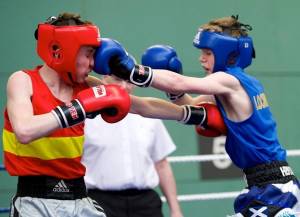
3. Gloves used in competition must have the following properties.
3.1 In competing, boxers must use gloves that are certified by the Office of the Boxing Commission according to the specified criteria. which Mr. Boxing Stadium or organized by boxing competition organizers only
3.2 Gloves used in competition The leather part of the glove must not weigh more than half of the total weight of the glove. And the part of the glove filling must have a weight of not less than half of the total weight of the glove. The padding must not be deformed or crushed to dissipate from its original shape.
3.3 The size of gloves used in competition is determined as follows.
3.3.1 Boxers from mini flyweight to featherweight must use 6 ounce (132 grams) gloves.
3.3.2 Boxers from super featherweight to welterweight must use 8 ounce (227 grams) gloves.
3.3.3 Boxers from super welterweight to super middleweight Requires a 10 ounce (284 g) mitt.
3.3.4 Boxers from light heavyweight and above must use gloves size 12 ounces (340 grams).
3.4 Tying the gloves Tie a knot behind the wrist. Wearing gloves must be inspected and stamped by a glove inspector assigned to Lumpini Boxing Stadium who must supervise the wearing of gloves to ensure that that the boxer acts correctly according to the rules until the boxer enters the ring
3.5 Other types of gloves that are not included in the rules and regulations of Muay Thai in Parts 1, 2, and 3 according to the Boxing Act of 1999, the style of gloves and others may be specified as appropriate. According to the model weight in Section 3.3
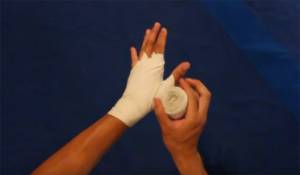
4. Hand wraps
4.1 Use hand wraps at Lumpini Boxing Stadium. or the organizer of the boxing match specified and provided only Do not use hand wraps other than those provided.
4.2 Use a soft hand wrap, no more than 6 meters long on each side and no more than 5 centimeters wide.
4.3 Use plaster. Or a rubber adhesive strip no more than 2.5 meters long on each side and 2.5 centimeters wide covering the wrist or back of the hand. Do not wrap it over the spine of the fist.
4.4 Hand wraps must be inspected and stamped by Lumpini Boxing Stadium officials to certify that they meet the requirements. So you can wear gloves.
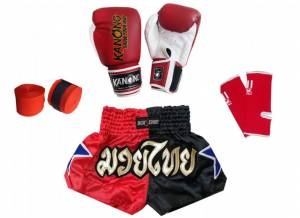
5. Clothing
5.1 Boxer's dress code
5.1.1 Wear shorts that are only halfway to the base of your knees, no shirts or shoes. Red corner boxers use red, pink, crimson, or white pants. Blue corner boxers use blue, navy blue, or black pants. Must wear designated robes.
5.1.2 Must wear a garter or protection made from strong material to cover the genitals. Can prevent danger from the knee or other organs By tying a knot in the back with a dead knot. Tie up the remaining ends of the rope.
5.1.3 Do not have long, unkempt hair. And don't grow a beard. Fingernails and toenails must be cut smooth and short.
5.1.4 Mongkhon must be worn only when paying respects to teachers before competing. During the competition, it is allowed to tie a Prachiat cloth (the hem of the Prachiat cloth is not more than 5 inches long), amulets, or takrud on the base of the arm or on the waist. But it must be covered with cloth.
neatly to prevent danger
5.1.5 Use an elastic band to strap your ankles to prevent sprains. Can wear no more than 1 anklet on each foot and must be worn on both feet.
The length must not exceed half of the shin. Do not slide up to form a shin guard. fold or roll down Do not use leg and ankle braces.
5.1.6 Do not use belts or accessories that are of dangerous materials.
5.1.7 Do not use Vaseline, hot oil, wax or herbs. or other things applied to the body and gloves.
5.1.8 Must wear a standard mouthguard.
5.2 Clothing violations
5.2.1 Other clothing Those that are specified in Section 5.1 must be removed before paying respect to teachers.
5.2.2 In the case that the boxer's clothing is not clean or incorrect Give the referee the power to order corrections.
5.3 Dress code that is not included in the rules and regulations of Muay Thai in Parts 1, 2, and 3 according to the Boxing Act of 1999, the dress form can be specified as appropriate.

6. Model classification and body weighing
6.1 Classification and determination of body weight used in competition
6.1.1 Mini Flyweight Body weight from 100 pounds (45.351 kg) and not more than 105 pounds (47.619 kg).
6.1.2 Light Flyweight Body weight must be no more than 105 pounds (47.619 kg) and no more than 108 pounds (48.979 kg).
6.1.3 Flyweight: Body weight must be over 108 pounds (48.979 kg.) and not more than 112 pounds (50.793 kg.).
6.1.4 Super Flyweight Body weight must be no more than 112 pounds (50.793 kg) and no more than 115 pounds (52.154 kg).
6.1.5 Bantamweight Body weight must be no more than 115 pounds (52.154 kg) and no more than 118 pounds (53.514 kg).
6.1.6 Super Bantamweight Body weight must be no more than 118 pounds (53.514 kg) and no more than 122 pounds (55.328 kg).
6.1.7 Featherweight Body weight must be no more than 122 pounds (55.328 kg) and no more than 126 pounds (57.142 kg).
6.1.8 Super Featherweight Body weight must be no more than 126 pounds (57.142 kg) and no more than 130 pounds (58.956 kg).
6.1.9 Lightweight: Body weight must be over 130 pounds (58.956 kg.) and not more than 135 pounds (61.224 kg.).
6.1.10 Super Lightweight version Body weight must be no more than 135 pounds (61.224 kg) and no more than 140 pounds (63.492 kg).
6.1.11 Welterweight Body weight must be no more than 140 pounds (63.492 kg) and no more than 147 pounds (66.666 kg).
6.1.12 Super Welterweight Body weight must be no more than 147 pounds (66.666 kg) and no more than 154 pounds (69.841 kg).
6.1.13 Middleweight Body weight must be no more than 154 pounds (69.841 kg) and no more than 160 pounds (72.562 kg).
6.1.14 Super Middleweight Body weight must be no more than 160 pounds (72.562 kg) and no more than 168 pounds (76.190 kg).
6.1.15 Light Heavyweight Body weight must be no more than 168 pounds (76.190 kg) and no more than 175 pounds (79.365 kg).
6.1.16 Cruiserweight Body weight must be no more than 175 pounds (79.365 kg) and no more than 190 pounds (86.167 kg).
6.1.17 Heavyweight Body weight must be over 190 pounds (86.167 kg. or more).
6.2 Weighing the body
6.2.1 Must be examined and certified by a doctor as being physically fit.
6.2.2 Boxers must weigh in without clothing. or wear underwear that does not affect the change in weight On competition day within 0800 - 1000 hrs. The competition must not be started before 3 hours after the weigh-in time. However, the boxing stadium manager may change. The time period can be set if there is a suitable reason.
6.2.3 When the weigh-in time ends, boxers who were overweight in the previous weigh-in will be weighed for the last time.
6.2.4 Boxing camp leader Managers or representatives of both boxers have the right Participate in checking body weight.
6.2.5 Boxers can compete with a weight difference of not more than 5 pounds, except for the heavyweight division.
6.2.6 When organizing a boxing match in a format other than those in the Muay Thai regulations and rules in Parts 1, 2, and 3 in accordance with the Boxing Sports Act of 1999, boxers must weigh themselves without clothing. or wear underwear that No effect on weight change 1 day before the competition. The boxing stadium manager can change the distance. Date and time if there is a suitable reason

7. Wai Khru and the number of rounds
7.1 Wai Kru Before starting the competition, boxers must dance the Wai Kru dance according to traditional arts. with clarinet and drumsticks Male and female drums and cymbals keep the rhythm of playing. When the boxer finishes paying respects to teachers So let the competition begin.
7.2 The number of rounds is standard in Muay Thai. The competition is scheduled to be 5 rounds, each round lasts 3 minutes, with a break between rounds of 2 minutes. The fight must be stopped to give an official warning, points will be deducted, the boxers' attire should be arranged neatly, or for any other reason. Others are not included in the competition time of each round. 7.3 The number of rounds that are not in the rules and regulations of Muay Thai in Parts 1, 2, and 3 according to the Boxing Sports Act of 1999, determine the format for the number of rounds and breaks, and Others can be done as appropriate. But must consider the safety of mainly boxer.
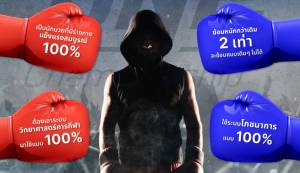
8. Boxers must have the following qualifications:
8.1 Age not less than 15 years.
8.2 Body weight of 100 pounds or more
8.3 Must have a boxer identification card and a boxer identification book. Issued by the Office of the Boxing Commission, Sports Authority of Thailand.
8.4 Must not have a prohibited disease as specified in the doctor's manual.
8.5 In the case of boxer qualifications that are not included in the regulations and rules of Muay Thai in Parts 1, 2, and 3 according to the Boxing Sports Act. 1999 can be further specified as appropriate.
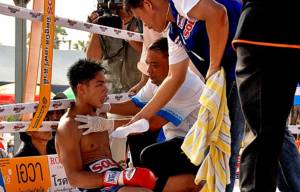
9. Mentors In general competition, each boxer can have 2 mentors and must notify the referee first. The competition begins Which nanny is the head nanny? Except in the case of competition for The championship competition has 3 mentors per side, and during the break, 2 mentors can enter the ring. The duties of the mentors are as follows.
9.1 Mentors must wear shirts showing the symbol of their boxing camp. and hang a card showing the status of the nanny at all times Perform duties as a nanny Must dress politely Don't wear a hat, don't wear dark glasses. and do not wear sandals.
9.2 The chaperone may arrange equipment, tools, and personal medical supplies in the corner as follows:
9.2.1 Water
9.2.2 Ice
9.2.3 Towels
9.2.4 Adrenaline 1/1000 or other substance approved by the field doctor.
9.2.5 Gauze to cover the wound
9.2.6 Cotton button stick
9.2.7 Round-ended scissors
9.2.8 Wound dressing tape
9.2.9 Cotton pads or soft wound dressings
9.3 Mentors are prohibited from using impolite language or attacking boxers. During the competition and after the competition.
9.4 During the competition, chaperones must remain at their assigned seats only. Before starting the competition
At each round, the chaperone brings a towel and a water bottle. and other equipment away from the edge of the stage.
9.5 Mentors are prohibited from using any type of communication device while performing their duties and are prohibited from passing any type of communication device to the boxer.
9.6 During the competition, chaperones are prohibited from giving advice, assistance or promotion. or send a signal or order a boxer. Do not compete seriously Mentors who break the rules or do not follow the referee's orders must be warned or removed from the game. Duties or fines for the boxer being the underdog or not being judged.
9.7 During breaks in the round, the chaperone must check the boxer's clothing to ensure that it is in good condition and ready. competition. If a problem arises, the mentor must notify the referee so that it can be resolved immediately.
9.8 Giving water to boxers The nanny must not let the boxer get soaked in water. and must not make the stage floor wet and slippery causing danger during the competition and must dry the boxer's body
9.9 The mentor may surrender on behalf of the boxer. By going on stage and informing the referee only. Do not throw sponges or a towel into the ring

10. The committee of judges of Lumpini Boxing Stadium Must have the qualifications of the judging committee as follows:
10.1 Civil servants, soldiers or police.
10.1.1 Be male or female, not less than 25 years of age, with good personality. The body is perfect and strong. Receive an annual health check to be a person with a perfect body and nervous system. in performing duties
10.1.2 Graduated with a high school education or equivalent or higher.
10.1.3 Have a rank of Sgt. or equivalent or higher.
10.1.4 Trained as a referee from the Boxing Sports Committee. Sports Authority of Thailand.
10.1.5 Have a referee's identification card. From the boxing sports committee Sports Authority of Thailand
10.1.6 Follow the regulations.
10.2 Civil servants or civilians
10.2.1 Be male or female, not less than 25 years of age, with good personality and a strong body. Receive an annual health check to be a person with good physical health. and nervous system Complete and ready to Performing duties.
10.2.2 Graduated with a bachelor's degree or equivalent or higher.
10.2.3 Engage in an honest occupation. Can be checked.
10.2.4 Trained as a referee from the Boxing Sports Committee. Sports Authority of Thailand
10.2.5 Have a referee's identification card. From the boxing sports committee Sports Authority of Thailand
10.2.6 Follow the regulations of the Boxing Sports Committee. Concerning the qualifications of judges, B.E. 2002
10.3 Code of Ethics of the Referee Committee.
10.3.1 Should behave as a good example in body, speech and mind.
10.3.2 Adhere to love and faith, be honest and honest. Responsible for the profession of directors
10.3.3 Perform duties with sincerity without asking for or accepting benefits from use Unlawful position
10.3.4 Do not criticize. or give an interview about the results of the competition which causes disrepute
10.3 Referee Those who do not comply with the rules and ethics will be considered for suspension from performing their duties. or removed from the committee of judges and in the case of disciplinary action when it is seen that the performance of duties of the referee and the scoring committee Inefficiency or decision making is not satisfactory or lacks fairness. The chairman and referee will report to the Lumpini Boxing Stadium manager. Consider continuing.
10.4 The judges must dress in blue or black trousers and a blue or other polite color shirt or t-shirt. The logo of Lumpini Boxing Stadium is attached to the left chest of the shirt. Wear light, black, flat-soled shoes with no heels. No glasses or metal jewelry. Fingernails cut neatly and short Do not grow long, unkempt hair and do not grow a beard or mustache.
10.5 In organizing a boxing match in a format other than those in the Muay Thai regulations and rules in Parts 1, 2, and 3 in accordance with the Boxing Act of 1999, the referee must dress as specified by the Lumpini Boxing Stadium.
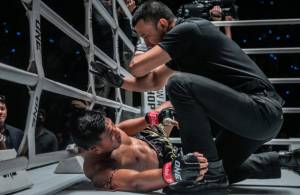
11. Arbiter
11.1 The steps for performing the duties of the referee on stage are as follows:
11.1.1 Enter the ring before the boxers by standing in the corner in a straight and dignified position. By placing your arms parallel to the top rope.
11.1.2 Check the completeness of equipment, gloves, clothing, mouthguards, ankle sprains, and body oil.
11.1.3 Give the signal for the pipe-drum band to play for the boxers to pay homage to their teachers and perform boxing dances.
11.1.4 Before competing in the first round, both boxers will shake hands in the middle of the ring and remind them of important rules.
11.1.5 Wipe the gloves before every round of competition. Give hand signals to order punches for rounds 1 - 5.
11.1.6 When the bell signal ends the round. The referee must immediately order “Stop” with a hand signal. and the arbiter enters his middle corner.
11.1.7 During the rest period The referee may warn the boxer. or a chaperone in the corner to keep them from breaking the rules Or consider the boxer's injury that occurred in the previous round.
11.1.8 If it is not necessary, you should not use your feet together or separate boxing, and you should not lift your feet high. To take the head of a boxer is considered an important art of banning boxing.
11.1.9 The referee collects the score sheets from all 3 scorers after the scorers have finished recording their scores. and take the score sheet and send it to the chairman of the referee or assigned person every round and return to stand in the corner
11.1.10 At the end of the competition, the referee Call both boxers to stand in the middle of the ring. The referee stands in the middle between the two boxers.
11.1.11 The referee raises his hand to the winning boxer according to the sum of the scores of the chairman, referee or designated person. Then send it to the stadium announcer to announce the results of the competition along with the scores.
11.1.12 If any boxer “Win by knockout” or “Win by technical knockout” have the referee raise his hand to the winning boxer in the middle of the ring. Then collect the score sheets from all 3 raters and send them to the chairman of the referee.
11.1.13 Let competitors shake hands or show respect or kindness in accepting the results of the competition.
11.1.14 The referee will be the last to leave the stage.
11.2 Duties of the referee
11.2.1 Strictly maintain the rules and be fair.
11.2.2 Check gloves and clothing. and a boxer's mouthguard
11.2.3 Must display polite behavior towards boxers and spectators.
11.2.4 Control the competition closely at every distance.
11.2.5 Be careful and protect weaker boxers from being unduly traumatized.
11.2.6 Use 3 commands:
- "Stop" when ordering a boxer to stop fighting.
- “Separate” when ordering the boxers to separate. In the case where the referee orders to "separate" the two boxers You must take at least 1 step back.
- "Punch" when ordering a boxer to punch.
11.2.7 Show correct signals to let boxers who break the rules know of their fault.
11.2.8 When a boxer breaks the rules and the referee makes one of the boxers lose or ends the competition. After announcing to the audience The reasons must be informed to the chairman of the referee.
11.2.9 Do not allow a boxer who breaks the rules to gain an advantage, such as holding the rope to kick, holding the rope to hit the knee, etc.
11.2.10 Do not do anything. that gives you punishment to any boxer, such as slow counting - fast counting, warning - not warning, etc., which affects the advantage or disadvantage.
11.2.11 At the end of each round, the score sheet of the 3 scorers must be collected and sent to the chairman of the referee. Then he raised the hand of the winning boxer. In the case of a draw, the referee will raise both boxers' hands together.
11.2.12 Do not criticize or give interviews about competition results that have not yet occurred. or has already occurred unless permission has been granted by the chairman of the referee.
11.3 Power of the arbiter
11.3.1 End the bout when it is seen that one boxer is much more skilled than the other. or acting on one side
11.3.2 End the competition when it is seen that the boxer is injured to the point of being unable to continue competing.
11.3.3 End the competition when it is seen that the boxers are not competing seriously. In such cases, one or both boxers may be removed from the competition without decision.
11.3.4 Stop the competition when you see that the boxer is injured, such as a serious wound. The referee may consult with the field doctor. Once discussed, the referee must follow the instructions.
11.3.5 Stop the competition to warn and deduct points from boxers who break the rules. or for any other reason in the interests of justice or to comply with the rules.
11.3.6 Stop counting when the opponent does not reach the farthest neutral corner. or coming out of the corner before the required count is completed
11.3.7 Give to a boxer who does not follow orders or is attacked. or aggressive towards the referee Adjusted to be the underdog or no judgment
11.3.8 The chaperone who does not follow orders or breaks the rules is removed from duty. or adjust the boxer to be the underdog or there will be no decision
11.3.9 Must not allow boxers who intend to break the rules. and gain an advantage, such as holding a rope and pulling out a boxing weapon Bending your back and hitting, etc.
11.3.10 The competition in any one round. When a boxer punches below the standard The referee has the right to stop the competition. or no verdict
11.3.11 Warning and punishing those who break the rules.
11.3.11.1 Give a warning to the boxers. so be careful or prevent them from doing things that violate the rules
11.3.11.2 Points deducted for those who break the rules. The referee must order the boxer to stop fighting and then clearly deduct points from those who break the rules. In order for the boxer to understand the reason and purpose of the deduction of points. The referee must give a hand signal and identify the boxer to let all scorers know that points have been deducted. In the case that a boxer's points are deducted 3 times, they will be forfeited or there will be no decision. If it is a serious violation of the rules, the boxer will be fined, losing or not having a decision. without ever having their points deducted before
11.3.12 Counting boxers who leave the ring
11.3.12.1 A boxer is attacked by an opponent with a Muay Thai weapon, causing him to leave the ring. The referee will begin counting. along with ordering the opponent to go to the farthest middle corner
11.3.12.2 Boxer falls from the ring
11.3.12.2.(1) When one or both boxers fall from the ring, the referee shall count to "twenty". If the boxer returns to the ring before counting to "twenty", the bout shall continue. and do not lose points
11.3.12.2.(2) When either boxer falls from the ring if he is prevented and restrained by any person. Not allowed to go on stage for the referee to stop counting. and give a clear warning and then continue counting If the obstructor disobeys Stop the competition and inform the chairman of the referee.
11.3.12.2.(3) When both boxers fall from the ring. Let the referee start counting. If either boxer tries to delay the count, he or she must stop the count and give a clear warning and then resume counting. If the boxer who is holding back does not obey, then that boxer will lose. or no judgment
11.3.12.2.(4) If both boxers fall from the ring Let the referee start counting. If any boxer returns to the ring before the count to twenty ends. Let that boxer be the winner. But if both boxers do not return to the ring when the count reaches twenty, to be decided as a tie
11.3.13 Interpreting the rules to enforce the facts or decide or act on matters not provided for in the rules shall be considered the power of the arbiter.
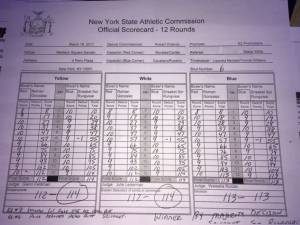
12. There are 3 scorers, each of whom must sit on different sides of the stage and have a distance from the audience. Their duties are as follows.
12.1 The rater gives independent scores. and according to the scoring criteria.
12.2 The scorer puts the score on the score card and signs it and sends it to the referee immediately at the end of each round.
12.3 Prohibit scorers Leave your seat until the referee has determined the outcome of the match.
12.4 During the competition Each scorer may not talk to the boxer or the scorer. or any other person Except if necessary during the break between rounds. can inform the referee that What events have occurred that may affect the competition? For example, the mentor breaks the rules, equipment on the stage must be fixed, etc. The referee may not notice at that time.
12.5 Do not criticize. or giving an interview about the results of a competition that has not yet happened or has already occurred unless permission has been granted by the chairman of the referee.

13. Chairman of the Referee
13.1 Duties of the chairman of the referee
13.1.1 Arrange referees and scorers to perform their duties in the competition.
13.1.2 Control the performance of duties of the referee and scorer in accordance with the rules and regulations.
13.1.3 Consider the performance of the duties of the referee and scorer. If any referee or scorer performs their duties incorrectly or is inefficient. Must report to the boxing stadium manager.
13.1.4 Solve problems arising from competition in all cases. and report to the boxing stadium manager
13.1.5 Provide advice to the referee. and those giving scores on matters that need to be decided
13.1.6 Check all score sheets. to see if the boxer's name is correct The total score is correct. Specify correct competition results The scorer has signed the score sheet. and when checked Report the results to the announcer to announce to the audience.
13.1.7 In the case of an abnormal event causing the referee, scorer and score collector to Unable to perform duties The chairman of the referee may take any action immediately. so that the competition can continue
13.1.8 Notify the boxing stadium manager to report to the boxing sports committee. In cases where a boxer commits a serious offense It is against the code of ethics and good sportsmanship.
13.2 Powers of the chairman of the referee can take corrective action The decision of the referee or scorer can be made in the following cases:
13.2.1 When the referee performs his duties or makes a decision that is clearly contrary to the rules.
13.2.2 When it is clear that the scorer Error in score sheet which results in the decision being incorrect
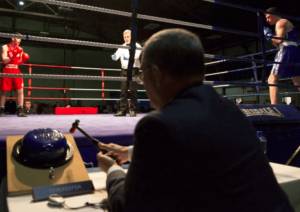
14. Timekeeper and Announcer
14.1 Duties of the time keeper
14.1.1 Maintain the number of rounds and the competition time of each round. Rest time between rounds and outside time.
14.1.2 Give the signal to start and end the round by ringing the bell.
14.1.3 Another 5 seconds before the start of each round. You must signal to the referee to prepare the ring for the next round.
14.1.4 Time deducted for pauses. or when the referee orders time to stop
14.1.5 Keep the correct time at all times with a pocket watch or table clock.
14.1.6 While the referee is counting The bell must not be signaled. Even though the competition time in that round has ended, the timekeeper will signal the bell when the referee orders "punch" and will then signal the end of the round by ringing the bell. If the referee counts to 10, the match is over.
14.2 Announcer duties.
14.2.1 Announce the names - affiliations - angles - weights of both boxers to the audience when the boxers appear on the stage.
14.2.2 Announcement for the mentor to leave the stage. Hearing the warning signal from the time keeper
14.2.3 Announcement of the start and end of each round.
14.2.4 Announce the scores of both boxers and indicate the decision results.

15. Judgment: In judging, there are the following decision guidelines:
15.1 Win by points at the end of the match. The boxer who receives the majority of points from the scorers is the winner.
15.2 Win by knockout. If a boxer "falls" and cannot continue fighting within 10 seconds, the boxer The opponent wins by knockout.
15.3 Win by technical knockout
15.3.1 When one boxer is much more skilled than the other or is acting One-sided until the competitor is in danger.
15.3.2 When one boxer is unable to continue the fight immediately. After taking a break between rounds
15.3.3 When one boxer is injured and unable to continue competing.
15.3.4 When one boxer is counted more than 2 times in the same round or more than 4 times throughout the bout.
15.3.5 When one boxer falls from the ring and the referee counted to "twenty" and was unable to return to the ring.
15.3.6 When one boxer voluntarily withdraws from the competition due to injury or other reasons.
15.4 Win by opponent is forfeited. When one boxer commits a serious violation of the rules The referee made that boxer lose, with a warning. or no warning or has not had scores deducted before
15.5 Win through in the event that one boxer does not pass the examination of the ring doctor. Did not pass the weigh-in or did not come to compete in the program Let the opposing boxer win through
15.6 Draw decision
15.6.1 When the results of the majority of scorers are tied. There is no winner by majority (red, blue, tie).
15.6.2 When both boxers are "down" and are counted to ten.
15.6.3 When both boxers fall from the ring and are counted to twenty.
15.6.4 When both boxers are injured to the point of being unable to continue competing.
15.7 No Judgment When the referee sees that one boxer or both sides "The fight was not worthy of dignity" and the match was ended by declaring that “There was no decision in this boxing match because (the red side, the blue side, or both sides) fought without dignity.”
15.8 No competition In the event that boxers do not fight The referee has given a warning and deducted points. If the fight has not yet been fought, the competition must be stopped and it will be announced that “There is no competition in this boxing match. Because both boxers do not fight each other.”
15.9 Cancel the competition. In the event that the stage is damaged The audience is not calm or unexpected events occur. until unable to continue competing Stop the competition and announce that "This boxing match has been cancelled."
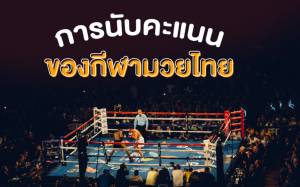
16. Scoring must be given according to the criteria in the case when a boxer uses punches, feet, knees, elbows as Muay Thai weapons to hit the opponent's body correctly according to the rules, with force, and hits the target and the opponent cannot defend.
16.1 Scoring is as follows:
16.1.1 Boxers who use Muay Thai weapons What does it mean to be able to do more right to your opponent than to be the winner of that round?
- Both boxers draw weapons. Who hits the target more? and the opponent cannot defend himself according to Muay Thai style. (Customs that have been established or that have been practiced and passed down from generation to generation, such as raising the leg to protect from kicking Raise your elbow to block a punch, etc.)
- Be diligent and use more weapons to hit the target.
16.1.2 The boxer who uses Muay Thai weapons to attack his opponent more forcefully, violently, and more clearly is the winner of that round.
16.1.3 Boxers who use Muay Thai weapons Acting against a competitor causing more trauma. was the winner in that round
16.1.4 The boxer who takes more offense is the winner of that round.
16.1.5 The boxer who has better offensive, defensive, dodge, and counter tactics according to the style and art of Muay Thai is the winner of that round.
16.1.6 Boxers who commit fewer violations was the winner in that round
16.2 Fights that do not receive points are as follows:
16.2.1 The boxer breaks any of the rules.
16.2.2 Touching the opponent's limb. in the form of self-defense
16.2.3 Act against the opponent, but lightly, without weight transferred from the body.
16.2.4 After kicking, the opponent grabs the leg and throws it to the ground, it is considered "a draw" if the kicking side Being caught by an opponent's legs and then pretending to drop to the ground is considered a violation of the rules. In this case, neither side is considered to have scored.
16.2.5 Throwing an opponent down without using any other weapons.
16.3 About Ratings There are criteria for scoring as follows:
16.3.1 Give a full score of 10 points to the winner of the round. And let the competitors be reduced in proportions to 9 - 8 - 7 and 6 without fractional scoring.
16.3.2 In a tied round, 10 points per side (10:10).
16.3.3 The winner of the round gets 10 points, the loser gets 9 points (10:9).
16.3.4 Big winner in the round. It means being able to use Muay Thai weapons to attack competitors. Hit the target clearly, hard, violently. The competitor shows signs of being hurt, weak, and unable to respond. When responding to weapons, there is no intensity, violence, and does not hit the target all the time, causing the opponent to be unable to defend himself. Moreover, when considering the previous round, it was seen that the win was much clearer, with 10 points, and the loser with 8 points (10:8).
16.3.5 The winner of the round and the opponent are counted 1 time and get 10 points, the loser gets 8 points (10:8).
16.3.6 The overwhelming winner of the round and the opponent is counted 1 time for 10 points, the loser is 7 points (10:7).
16.3.7 The winner of the round and the opponent are counted twice, get 10 points, the loser get 7 points (10:7)
16.3.8 The winner of the round and the opponent counted twice scores 10 points, the loser scores 6 points (10:6).
16.3.9 Boxers whose points were deducted Must not get full points in that round, the referee can deduct points by 1 point at a time.
16.3.10 The winner of the round but is counted out gets 10 points, the loser gets 9 points (10:9)
16.3.11 Big winner in the round. The competitors clearly showed their hurt. But they were counted on 10 points each (10:10)
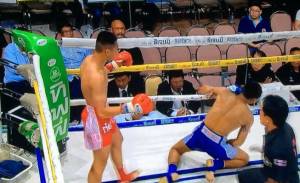
17. Procedures for boxers who do not fight at Lumpini Boxing Stadium.
17.1 When the competition begins in the 1st round, both boxers do not fight. After the boxers have seen the tactics and 2 minutes have elapsed, the referee must stop and give a first warning.
17.2 When the competition begins in the second round and 1.30 minutes has elapsed, both boxers do not fight, the referee must stop. 2nd warning
17.3 When the competition begins in the 3rd round and 1.30 minutes has elapsed, both boxers do not fight. Let the referee stop. Third warning and points deducted from both boxers. After the score has been deducted and 30 seconds have elapsed, the referee shall stop the competition. and announce to the audience “There is no competition in this boxing match. Because the boxers on both sides did not fight.”
17.4 In the case of the 5th round which is the last round. Both boxers Do not fight at the start of the competition. or the competition has already passed and there is still more than 1 minute remaining, the referee must stop giving the first warning within 15-20 seconds. When the warning has been given and both boxers still refuse to fight, the referee must stop giving the second warning within 15-20 seconds. Seconds, after warning, they still refused to fight. Give a third warning and deduct points from both boxers and announce to the audience that “There is no competition in this boxing match. Because the boxers on both sides did not fight.”
17.5 In the case of the 5th round which is the last round. An exception is made according to Section 17.4 when both boxers They didn't fight because they competed for 4 full rounds and were clearly hurt. and the boxer with the leading score Show good sportsmanship by not being a competitor. The other two competitors have shown signs or accepted it. In this case, the referee must allow both boxers to show good sportsmanship or end the contest in favor of the one with the lead. "Knockout Technique"

18. Acts that break the rules Boxers who do the following It is considered against the rules.
18.1 Biting, pricking the eye Spitting at an opponent, sticking out their tongue, using their head to butt or headbutt
18.2 hrs. Bending the back, locking the opponent's arms, using judo and wrestling moves.
18.3 Falling over or aggravating a fallen competitor. or getting up
18.4 Hold the rope to punch. or find other benefits
18.5 Use inappropriate language in competition.
18.6 Failure to follow the referee's orders.
18.7 Use your knee to hit your opponent's chest, such as grabbing your neck and hitting your knee on your opponent's chest. Stab the knee in the chest. Or throw a knee that catches your chest. The referee shall do the following:
18.7.1 A boxer who has a knee on his chest cannot continue competing. It is decided that the boxer who hit the knee on the chest will lose with a forfeit or no decision.
18.7.2 A boxer who is hit by a knee in the chest can rest for no more than 5 minutes at a time. When the rest time is over.
Didn't come out to compete. Collect the scores from every round and deduct 1 point from the person who broke the rules, so the scores are totaled.
So the winner was announced.
18.7.3 If the boxer who was hit by a knee can continue to compete. Let the referee warn or cut. Score of the boxer who hit the knee.
18.8 Grab your opponent's legs and push them forward more than 2 steps without using any weapons. The referee must stop and give a warning. If two warnings have been given, the referee will deduct points from the offender.
18.9 A boxer who kicks is caught by the opponent's leg. Pretending to throw yourself on the ground is considered an advantage to your opponent. Let the referee warn If there is another offense and the referee has already given two warnings, the referee will order the offender's points to be deducted.
18.10 When both boxers fall from the ring. If either side tries to delay
18.11 Use prohibited substances as specified by the Medical Committee of the Boxing Sports Committee.
18.12 Violation of any of the rules
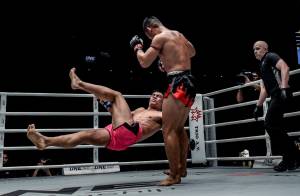
19. “Falling”
19.1 To “fall” means to be hit by an opponent's punch, foot, knee, or elbow.
19.1.1 Any part of the body other than the feet touches the stage floor.
19.1.2 Standing, folding, leaning or sitting on a rope.
19.1.3 Any part of the body or the whole body goes out of the ring
19.1.4 Has been severely treated but has not yet "fallen" and is in a state of being unable to defend himself.
19.2 Rules to follow when “falling”
19.2.1 In the event that a boxer is "fallen", 1 second must elapse before the referee begins counting by counting out loud from 1 to 10, 1 second apart, and must show hand signals in counting. To let the fallen boxer know the count and order the opponent to enter the center farthest corner immediately. If the competitor refuses to follow orders The referee must stop counting until he has complied and then continue counting. From what has been counted, when the "fallen" person gets up and is ready to compete, the referee orders the fight to continue.
19.2.2 In the event that the "fallen" boxer gets up before the referee counts to "ten" and is ready to continue the fight. But if the count has not reached "eight", the referee must continue counting until "eight" before continuing the competition.
19.2.3 If the boxer who "fell" is ready to continue the bout before counting to "ten" but falls down without further action, the referee shall continue counting from what has already been counted.
19.2.4 In the event that the referee has counted to "ten", it is considered that the competition has ended. and judge those who fall “Lost by knockout”
19.2.5 In the case where both boxers "fall" at the same time Let the referee continue counting as long as one person is down. If both boxers are down until the count of "ten", it will be decided as a draw.
19.2.6 In the case where both boxers "fall" at the same time Any part of the body accidentally intertwined or overlapped. With the boxer getting up, the referee stopped counting. and separated the two boxers from each other Then continue counting if there are still "fallen" boxers.
19.2.7 In the event that any boxer is not ready to continue competing immediately. After the break time between rounds has expired, the referee must count. Unless the costumes are incomplete or the stage floor is not ready for the competition.

20. The field doctor must be on duty throughout the competition at the designated place until the last match ends. and has the following duties.
20.1 Physical examination of boxers before weigh-in. To prove that boxers have complete strength. There is no disease or illness that is prohibited as specified in the announcement of the medical manual of the Boxing Sports Committee.
20.2 Give advice to the referee. upon request.
20.3 Provide assistance to boxers who are unconscious from the competition. Only doctors are allowed into the ring. Others may enter the ring. If the doctor needs special assistance.
20.4 Provide medical assistance to boxers who are knocked out or technical knocked out. By a thorough physical examination and provide immediate medical treatment.
20.5 Physically examine and diagnose boxers after the competition to inform the recovery period before the next competition according to the following requirements.
20.5.1 After 5 rounds, boxers must take a physical break before competing. The next time is not less than 21 days.
20.5.2 Boxers who win within 1 round must rest their bodies for no less than 7 days.
20.5.3 Boxers who win within 3 rounds must rest their bodies for no less than 14 days.
20.5.4 Boxers who lost by knockout or technical knockout Must take a physical break of not less than 30 days in the case of a boxer who loses by knockout or technical knockout. He was hit in the head 2 times in a row. Physical rest must be at least 90 days and must be certified by a doctor in order to compete.
20.5.5 After recovery Boxers must be certified by a doctor to compete.

21. Prohibited drugs or substances
21.1 Arrangement for boxers to use medicine or any chemicals which is not a part of the boxer's normal food intake It is considered a prohibited action.
21.2 Various prohibited substances It shall be as announced by the Medical Committee of the Boxing Sports Committee.
21.3 Boxers who use prohibited substances or those who bring banned substances for boxers to take or use must be punished according to law.
21.4 Boxers or officials that violates the prohibition on the use of prohibited substances must be punished by not being able to compete or prohibited from participating in the competition.
21.5 Boxers who do not undergo medical examinations After the competition ends, which is a violation of these rules. That boxer will be banned from further competition. Officials who encourage boxers to commit such crimes will also be banned from participating in the competition.

22. Interpretation in case of any problems Happens in competition or as a result of competition. which is not specified in these rules The referee or the chairman of the referee will make the final decision. and notify the boxing stadium manager.
Comment
| Keyword (Advance) |
 Facebook Fanpage
Facebook Fanpage



 Category:
Category:  Group:
Group:  Historical Sites and Monuments(
Historical Sites and Monuments( Landmarks and Memorials(
Landmarks and Memorials( Royal Palace(
Royal Palace( Museums(
Museums( Educational Places
Educational Places Museum for Study(
Museum for Study( Educational Gardens, Farm(
Educational Gardens, Farm( Training Center(
Training Center( University
University Places of Worship
Places of Worship Temple(
Temple( Church(
Church( Mosque(
Mosque( Other religious and spiritural sites(
Other religious and spiritural sites( Research and Development
Research and Development Royal Project(
Royal Project( Suburban Living
Suburban Living Village, Community(
Village, Community( Local Market(
Local Market( Floating Market(
Floating Market( Nature and Wildlife
Nature and Wildlife Dam, Reservoir, Lake(
Dam, Reservoir, Lake( River, Canal(
River, Canal( Islands(
Islands( Other natural attractions(
Other natural attractions( Entertainment and Agricultural
Entertainment and Agricultural Animal camps and shows(
Animal camps and shows( Farm, Parks, Gardens and Ecotourism(
Farm, Parks, Gardens and Ecotourism( Travel Articles, Recipes
Travel Articles, Recipes Travel Review, Food Review(
Travel Review, Food Review(